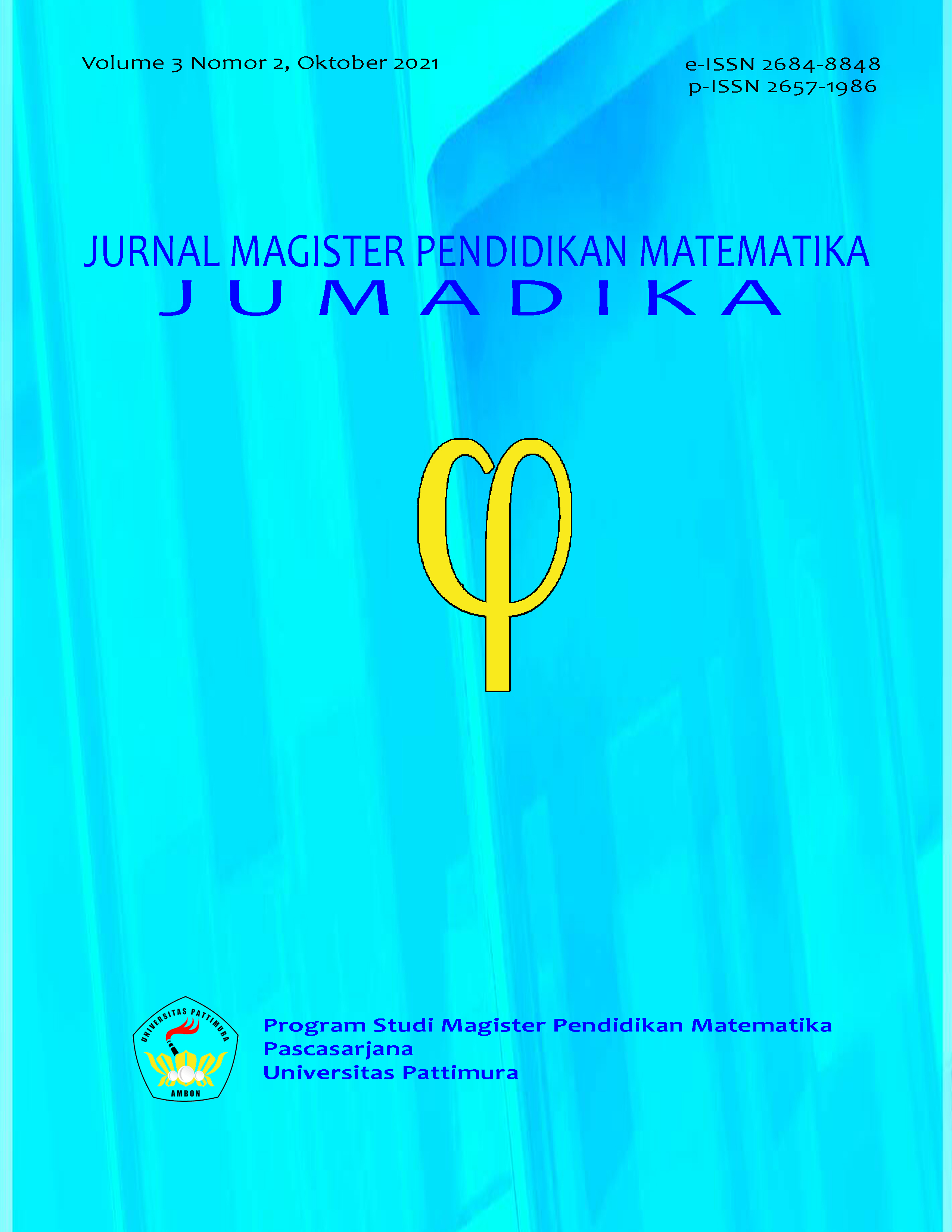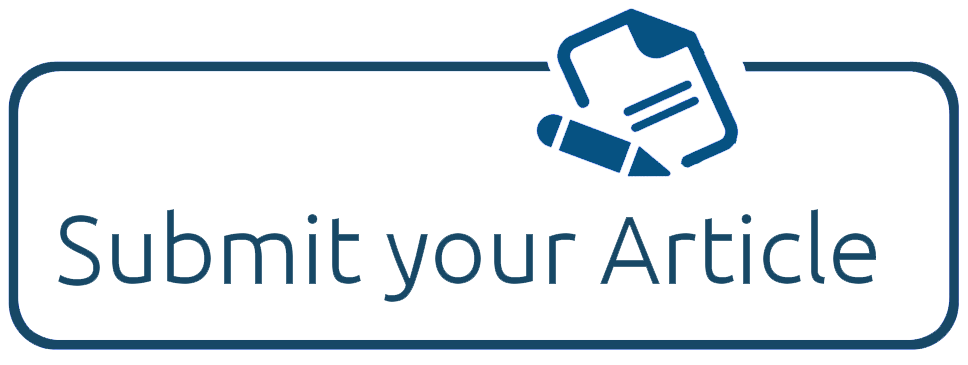PENGEMBANGAN MEDIA PEMBELAJARAN DESAIN GRAFIS DAN ANALISIS REAL BERBASIS DIGITAL
Abstract
Penelitian ini bertujuan mengembangkan media pembelajaran mata kuliah desain grafis dan analisis real yang berbasis digital. Pembelajaran dengan media berbasis digital ini menggunakan pendekatan blended learning. Penelitian pengembangan mengacu pada model pengembangan Alessi dan Trolip yang terdiri atas fase perencanaan, desain, dan pengembangan. Subjek penelitian adalah mahasiswa program studi pendidikan matematika Fakultas Keguruan dan Ilmu Pendidikan Universitas Pattimura yang menawarkan mata kuliah desain grafis dan analisis real. Instrumen yang digunakan adalah angket untuk mengetahui hasil validasi ahli media dan ahli materi serta respons siswa terhadap media pembelajaran yang dihasilkan. Hasil penelitian menunjukkan bahwa media pembelajaran berbasis digital layak untuk digunakan.
Downloads
References
Admadja, I. P., & Marpanaji, E. (2016). Pengembangan Multimedia Pembelajaran Praktik Individu Instrumen Pokok Dasar Siswa Smk Di Bidang Keahlian Karawitan. Jurnal Pendidikan Vokasi, 6(2), 173. https://doi.org/10.21831/jpv.v6i2.8107
Arikunto, S. 1999. Prosedur Penelitian S uatu Pendekatan Praktek. Jakarta: Rineka Cipta
Balkis, A. R., Darlius, D., & Asri, A. F. (2015). Pengembangan E-Book sebagai Bahan Ajar pada Poko Bahasan Sistem Bahan Bakar Bensin di Kelas XI TKR SMK PGRI Tanjung Raja. Jurnal Pendidikan Teknik Mesin, 2(2). https://doi.org/10.36706/JPTM.V2I2.5333
Darma Wisada, P., Komang Sudarma, I., & Wayan Ilia Yuda S, A. I. (2019). Pengembangan Media Video Pembelajaran Berorientasi Pendidikan Karakter. Journal of Education Technology, 3(3), 140–146.
Daryanto. 2010. Media Pembelajaran. Bandung: Satu Nusa
Güler, G. (2016). The Difficulties Experienced in Teaching Proof to Prospective Mathematics Teachers: Academician Views. Higher Education Studies, 6(1), 145. https://doi.org/10.5539/hes.v6n1p145
Hake, R. R. (1998). Interactive-engagement versus traditional methods: A six-thousand-student survey of mechanics test data for introductory physics courses. American Journal of Physics, 66(1), 64–74. https://doi.org/10.1119/1.18809
Harini, L., Astawa, G., & Srinadi, G. (2014). Eksplorasi Miskonsepsi Mahasiswa Dalam Pengembangan Buku Teks Analisis Real Bermuatan Peta Pikiran. Seminar Nasional Sains Dan Teknologi, September, 941–949. https://www.researchgate.net/publication/285592489_EKSPLORASI_MISKONSEPSI_MAHASISWA_DALAM_PENGEMBANGAN_BUKU_TEKS_ANALISIS_REAL_BERMUATAN_PETA_PIKIRAN
Krisna, F. P. P., & Marga, M. H. P. (2017). Pemanfaatan Video Untuk Pembelajaran Matematika Berbasis Masalah Konstektual Pada Topik Aljabar. In Prosiding Seminar Nasional Etnomatnesia (Vol. 4, Issue 2).
Li, J. Y., & Shieh, C. J. (2016). A study on the effects of multiple goal orientation on learning motivation and learning behaviors. Eurasia Journal of Mathematics, Science and Technology Education, 12(1), 161–172. https://doi.org/10.12973/eurasia.2016.1221a
Meilani, M. (2014). Berbudaya Melalui Media Digital. Humaniora, 5(2), 1009. https://doi.org/10.21512/humaniora.v5i2.3210
Meltzer, D. E. (2002). The relationship between mathematics preparation and conceptual learning gains in physics: A possible “hidden variable” in diagnostic pretest scores. American Journal of Physics, 70(12), 1259–1268. https://doi.org/10.1119/1.1514215
Palinussa, A. L., & Mananggel, M. B. (2021). Model Pembelajaran Flipped Classroom. AKSIOMA: Jurnal Program Studi Pendidikan Matematika, 10(3), 1809–1822.
Perbowo, K. S., & Pradipta, T. R. (2017). Pemetaan Kemampuan Pembuktian Matematis Sebagai Prasyarat Mata Kuliah Analisis Real Mahasiswa Pendidikan Matematika. KALAMATIKA Jurnal Pendidikan Matematika, 2(1), 81. https://doi.org/10.22236/kalamatika.vol2no1.2017pp81-90
Plomp, T., & Nieveen, N. (2014). Educational design research. Handbook of Research on Educational Communications and Technology: Fourth Edition, January 2013, 131–140. https://doi.org/10.1007/978-1-4614-3185-5_11
Purwanti, B. (2015). Pengembangan Media Video Pembelajaran Matematika dengan Model Assure. Jurnal Kebijakan Dan Pengembangan Pendidikan, 3(1), 42–47. http://ejournal.umm.ac.id/index.php/jmkpp/article/view/2194
Admadja, I. P., & Marpanaji, E. (2016). Pengembangan Multimedia Pembelajaran Praktik Individu Instrumen Pokok Dasar Siswa Smk Di Bidang Keahlian Karawitan. Jurnal Pendidikan Vokasi, 6(2), 173. https://doi.org/10.21831/jpv.v6i2.8107
Balkis, A. R., Darlius, D., & Asri, A. F. (2015). Pengembangan E-Book sebagai Bahan Ajar pada Poko Bahasan Sistem Bahan Bakar Bensin di Kelas XI TKR SMK PGRI Tanjung Raja. Jurnal Pendidikan Teknik Mesin, 2(2). https://doi.org/10.36706/JPTM.V2I2.5333
Daryanto. 2010. Media Pembelajaran. Bandung: Satu Nusa
Güler, G. (2016). The Difficulties Experienced in Teaching Proof to Prospective Mathematics Teachers: Academician Views. Higher Education Studies, 6(1), 145. https://doi.org/10.5539/hes.v6n1p145
Hake, R. R. (1998). Interactive-engagement versus traditional methods: A six-thousand-student survey of mechanics test data for introductory physics courses. American Journal of Physics, 66(1), 64–74. https://doi.org/10.1119/1.18809
Li, J. Y., & Shieh, C. J. (2016). A study on the effects of multiple goal orientation on learning motivation and learning behaviors. Eurasia Journal of Mathematics, Science and Technology Education, 12(1), 161–172. https://doi.org/10.12973/eurasia.2016.1221a
Meltzer, D. E. (2002). The relationship between mathematics preparation and conceptual learning gains in physics: A possible “hidden variable” in diagnostic pretest scores. American Journal of Physics, 70(12), 1259–1268. https://doi.org/10.1119/1.1514215
Plomp, T., & Nieveen, N. (2014). Educational design research. Handbook of Research on Educational Communications and Technology: Fourth Edition, January 2013, 131–140. https://doi.org/10.1007/978-1-4614-3185-5_11
Ratumanan, T. G. & Laurens, Th. 2015. Penilaian Hasil Belajar pada Tingkat Satuan Pendidikan. Yogyakarta: Pensil Komunika
Sari, C. K., Waluyo, M., Ainur, C. M., & Darmaningsih, E. N. (2017). Menggunakan Contoh Dalam Pembuktian. JIPMat, 2(1), 1–9. https://doi.org/10.26877/jipmat.v2i1.1475
Sadiman. 2008. Interaksi dan Motivasi Belajar Mengajar. Jakarta: PT Radja Grafindo Persada
Sari, C. K., Waluyo, M., Ainur, C. M., & Darmaningsih, E. N. (2017). Menggunakan Contoh Dalam Pembuktian. JIPMat, 2(1), 1–9. https://doi.org/10.26877/jipmat.v2i1.1475
Sucipto, L., & Mauliddin, M. (2017). Analisis Kesulitan Belajar Mahasiswa Dalam Memahami Konsep Bilangan Real. Beta Jurnal Tadris Matematika, 9(2), 197. https://doi.org/10.20414/betajtm.v9i2.37
Sugiyono. 2009. Metode Penelitian Pendidikan. Bandung: Alfabeta
Sutrisno. 2011. Pengantar Pembelajaran Inovatif Berbasis Teknologi Informasi dan Komunikasi. Jakarta: Gaung Persada Press
Yudianto, A. (2017). Penerapan Video Sebagai Media Pembelajaran. Seminar Nasional Pendidikan 2017, 234–237.
Copyright (c) 2021 Theresia Laurens, Marlin Blandy Mananggel, Fentje Sapulette

This work is licensed under a Creative Commons Attribution-NonCommercial-ShareAlike 4.0 International License.
License and Copyright Agreement
In submitting the manuscript to the journal, the authors certify that:
- They are authorized by their co-authors to enter into these arrangements.
- The work described has not been formally published before, except in the form of an abstract or as part of a published lecture, review, thesis, or overlay journal. Please also carefully read Jurnal Magister Pendidikan Matematika (JUMADIKA) Posting Your Article Policy.
- That it is not under consideration for publication elsewhere,
- That its publication has been approved by all the author(s) and by the responsible authorities – tacitly or explicitly – of the institutes where the work has been carried out.
- They secure the right to reproduce any material that has already been published or copyrighted elsewhere.
- They agree to the following license and copyright agreement.
Copyright
Authors who publish with Jurnal Magister Pendidikan Matematika (JUMADIKA) agree to the following terms:
- Authors retain copyright and grant the journal right of first publication with the work simultaneously licensed under a Creative Commons Attribution-NonCommercial-ShareAlike 4.0 International License (http://creativecommons.org/licenses/by-nc-sa/4.0/) that allows others to share the work with an acknowledgment of the work's authorship and initial publication in this journal.
- Authors are able to enter into separate, additional contractual arrangements for the non-exclusive distribution of the journal's published version of the work (e.g., post it to an institutional repository or publish it in a book), with an acknowledgment of its initial publication in this journal.
- Authors are permitted and encouraged to post their work online (e.g., in institutional repositories or on their website) prior to and during the submission process, as it can lead to productive exchanges, as well as earlier and greater citation of published work.








